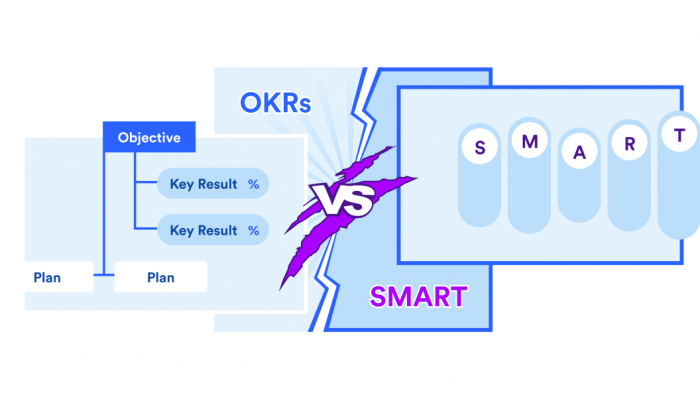In today’s business world, having a clear and actionable plan for scaling your company is more important than ever. But how do you know if you’re setting the right goals? Many times, businesses struggle not because of a lack of effort but rather how their goals have been structured.
In fact, a staggering 65% of businesses fail within the first decade, and a mere 25% make it to 15 years or more. The difference? A laser-like focus on tangible objectives.
That’s why companies worldwide have implemented different goal-setting frameworks to propel their businesses forward. Some of the most successful corporate giants, such as Google, Amazon, and Facebook, have all utilized different versions of goal-setting methodologies to achieve their current level of success, and so can you!
However, with so many different methods out there, it can be hard to know which framework is best for your company as there are so many factors to consider.
With this in mind, we’ve decided to compare and contrast two of the most popular goal-setting methods: OKR vs. SMART goals. We’ll explore the key differences between these two frameworks, why they’re so popular among businesses, and which one might be best for your company.
What are OKRs?
OKR, or Objectives and Key Results, is a goal-setting framework popularized by tech companies in Silicon Valley in the early 2000s but has since been adopted by businesses in a wide range of industries.
Usually, OKRs are created with an Objective at the top and 3 to 5 Key Results that support it below.
This type of methodology should be qualitative in nature:
I will (Objective) as measured by (Key Results).
John Doerr’s OKR Formula
The objective defines what the employee wants to achieve and the key results outline how they will achieve it within a specific time frame. Each overarching objective should have a “committed (roofshot)” or “aspirational (moonshot)” goal.
Moonshot OKRs are more visionary and only likely to get completed 70% of the time, but they should force teams to rethink their working processes and push their limits.
On the other hand, roofshot OKRs are ones that your business has agreed to execute and should have a clear business plan for achieving, meaning that you are almost certain you can meet it with 100% completion.
For example, an OKR could look a little something like this:
Objective: Become the region’s leading provider of innovative healthcare technology
KR 1: Increase our share in the healthcare market from 20% to 40%
KR 2: Improve our customer satisfaction rating of our healthcare technology products by 3.5 points
KR 3: Generate 60% more leads to increase brand visibility.
The key results are then monitored on a shorter quarterly basis to check if the company is actively progressing toward its objectives.
What are SMART goals?

SMART goals are another popular goal-setting framework used by businesses of all sizes. The general idea behind SMART goals is to set Specific, Measurable, Achievable, Relevant, and Time-bound goals.
Like OKRs, SMART goals provide a way to measure progress and ensure that objectives are being met. However, unlike OKRs, SMART goals don’t necessarily need to be aligned with the company’s overall strategy or (mission) to be effective. This is because SMART goals are typically shorter-term in nature so that they can be more specific to a particular team or department within a company, and they’re typically project-based
For example, a SMART goal for a marketing team might be to increase website traffic by 20% over 3 months so that more people are aware of the company’s new product launch. This is a specific, measurable, achievable, relevant, and time-bound goal that the team can work towards
Comparing OKRs and SMART goals
Now that we’ve covered the basics of OKRs and SMART goals, let’s take a closer look at how these two frameworks compare.
Difference #1: Strategy
The first key difference between OKRs and SMART goals is the role that strategy plays in each framework. With OKRs, objectives must be aligned with the company’s overall strategy or mission to be effective. This ensures that everyone in the company is working towards the same goal and that resources are being used effectively.
As mentioned before, SMART goals don’t necessarily need to be aligned with the company’s strategy. This can be both a good and a bad thing, depending on the business. On the one hand, it allows companies to set goals that are more relevant to their current situation. On the other hand, failing to align short-term goals with your company’s long-term vision can harm your company’s growth prospects and relationships with clients.
Difference #2: Implementation
You can create OKRs top-down, cross-functionally, or bottom-up. This allows for input from a greater number of groups and creates opportunities for broader conversations.
SMART goals however are designed for individuals, so they have a top-down approach. This makes them more authoritative and concrete, but less aligned with the overall organization.
Difference #3: Focus
The final key difference between OKRs and SMART goals is the focus of each framework. OKRs are typically designed to focus on long-term objectives, whereas SMART goals usually focus on specific projects or initiatives.
So, which framework is right for your business?
Simple answer: OKRs.
SMART goals do not help create clear and distinct alignment among a company’s employees. In an organizational setting, the number of SMART goals can often become too troublesome and confusing. So while SMART goals may help individuals, they are impractical for businesses.
Organizations that implement OKRs see a clear improvement in their goal-setting structures. This is due to the fact that OKRs require businesses to evaluate what matters most regularly. For more efficient results, organizations should establish a strategy that involves checking in on progress every week.
In addition, SMART goals force teams and individuals to focus on just one small goal, rather than constantly striving to improve the company as a whole. By making sure that team OKRs are in line with company Objectives, those working within the organization will have a detailed understanding of not only what other teams are up to but also how their efforts play into larger objectives. For this reason, OKRs create a better sense of value for the company.
If you need extra guidance in setting up your OKRs, Weekdone OKR coaches can help you assess your needs and make a recommendation on how best to implement the roll-out in your company.
Final thoughts
Goal-setting is one of, if not the most important aspect of running a successful business. Without direction and ways to measure progress, it can be difficult to make real headway.
Ultimately, after comparing OKRs vs SMART goals, it’s clear that OKRs are the superior framework for businesses. Not only do they require alignment with the company’s strategy, but they also allow for input from a greater number of employees which creates a space for more collaborative efforts and focus on long-term objectives.
If you’re looking to implement a goal-setting system for your business, we recommend using OKRs. You won’t be disappointed.

